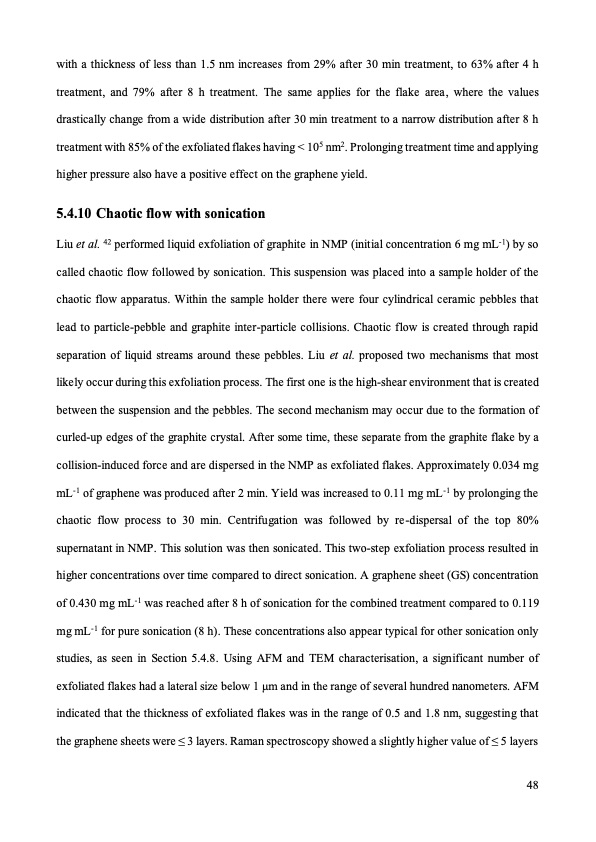PDF Publication Title:
Text from PDF Page: 048
with a thickness of less than 1.5 nm increases from 29% after 30 min treatment, to 63% after 4 h treatment, and 79% after 8 h treatment. The same applies for the flake area, where the values drastically change from a wide distribution after 30 min treatment to a narrow distribution after 8 h treatment with 85% of the exfoliated flakes having < 105 nm2. Prolonging treatment time and applying higher pressure also have a positive effect on the graphene yield. 5.4.10 Chaotic flow with sonication Liu et al. 42 performed liquid exfoliation of graphite in NMP (initial concentration 6 mg mL-1) by so called chaotic flow followed by sonication. This suspension was placed into a sample holder of the chaotic flow apparatus. Within the sample holder there were four cylindrical ceramic pebbles that lead to particle-pebble and graphite inter-particle collisions. Chaotic flow is created through rapid separation of liquid streams around these pebbles. Liu et al. proposed two mechanisms that most likely occur during this exfoliation process. The first one is the high-shear environment that is created between the suspension and the pebbles. The second mechanism may occur due to the formation of curled-up edges of the graphite crystal. After some time, these separate from the graphite flake by a collision-induced force and are dispersed in the NMP as exfoliated flakes. Approximately 0.034 mg mL-1 of graphene was produced after 2 min. Yield was increased to 0.11 mg mL-1 by prolonging the chaotic flow process to 30 min. Centrifugation was followed by re-dispersal of the top 80% supernatant in NMP. This solution was then sonicated. This two-step exfoliation process resulted in higher concentrations over time compared to direct sonication. A graphene sheet (GS) concentration of 0.430 mg mL-1 was reached after 8 h of sonication for the combined treatment compared to 0.119 mg mL-1 for pure sonication (8 h). These concentrations also appear typical for other sonication only studies, as seen in Section 5.4.8. Using AFM and TEM characterisation, a significant number of exfoliated flakes had a lateral size below 1 μm and in the range of several hundred nanometers. AFM indicated that the thickness of exfoliated flakes was in the range of 0.5 and 1.8 nm, suggesting that the graphene sheets were ≤ 3 layers. Raman spectroscopy showed a slightly higher value of ≤ 5 layers 48PDF Image | graphene production via nonoxidizing liquid exfoliation

PDF Search Title:
graphene production via nonoxidizing liquid exfoliationOriginal File Name Searched:
Graphene-R2-review.pdfDIY PDF Search: Google It | Yahoo | Bing
Salgenx Redox Flow Battery Technology: Power up your energy storage game with Salgenx Salt Water Battery. With its advanced technology, the flow battery provides reliable, scalable, and sustainable energy storage for utility-scale projects. Upgrade to a Salgenx flow battery today and take control of your energy future.
CONTACT TEL: 608-238-6001 Email: greg@infinityturbine.com (Standard Web Page)